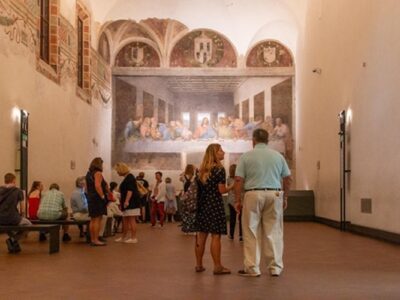Cuba, the largest island in the Caribbean, is a vibrant melting pot of cultures, histories, and traditions. This captivating country offers a unique and enriching experience for travelers seeking to immerse themselves in its rich cultural tapestry.
Here are seven compelling reasons why Cuba is the ultimate cultural experience.
1. A Living Museum of History
Cuba is often described as a living museum, with its streets lined with well-preserved colonial architecture and vintage American cars. Havana, the capital city, is a prime example of this historical preservation. The city’s old quarter, Habana Vieja, is a UNESCO World Heritage site, where visitors can wander through cobblestone streets, marvel at grand plazas, and explore centuries-old fortresses and cathedrals. Each building tells a story, reflecting Cuba’s complex past, from Spanish colonization to revolutionary fervor.
The Museum of the Revolution, housed in the former presidential palace in Havana, provides a detailed account of the Cuban Revolution, featuring exhibits that showcase significant moments and figures in Cuban history. This immersion into Cuba’s past makes it a unique cultural experience that transports visitors back in time.
2. Vibrant Music and Dance
Music and dance are integral to Cuban culture, with rhythms and movements that are famous worldwide. From the infectious beats of salsa and rumba to the soothing sounds of son and trova, Cuban music is a celebration of life and passion. In cities like Havana and Santiago de Cuba, live music can be found on every corner, from intimate bars to grand theaters.
The Casa de la Música in Havana is a must-visit for anyone looking to experience authentic Cuban music. Here, you can dance the night away to live bands, enjoying the talents of some of Cuba’s best musicians. For a more traditional experience, visit the Casa de la Trova in Santiago de Cuba, where trova music, characterized by its poetic lyrics and acoustic guitars, has been celebrated for decades.
3. Rich Literary Heritage
Cuba has a rich literary tradition, with renowned authors such as José Martí, Alejo Carpentier, and Nicolás Guillén contributing to its literary landscape. The country’s love for literature is evident in its numerous bookstores, libraries, and literary events. Havana’s International Book Fair, held annually in February, attracts writers, publishers, and readers from around the world, offering a week-long celebration of books and literature.
A visit to the Ernest Hemingway Museum in Havana, located in the author’s former home, Finca Vigía, provides insight into the life and works of the famous writer. Hemingway’s time in Cuba greatly influenced his writing, and the museum preserves his legacy, with original manuscripts, photographs, and personal belongings on display.
4. Diverse Culinary Scene
Cuban cuisine is a flavorful fusion of Spanish, African, and Caribbean influences. Traditional dishes such as ropa vieja (shredded beef), moros y cristianos (black beans and rice), and lechón asado (roast pork) showcase the island’s rich culinary heritage. Street food, such as churros, empanadas, and tamales, offers a delicious and affordable way to sample local flavors.
Paladares, privately-owned restaurants often run out of family homes, provide an authentic dining experience. These establishments offer a more personalized and intimate setting, allowing visitors to savor home-cooked meals and engage with local chefs. For food enthusiasts, taking part in group tours in Cuba that include culinary experiences can be an excellent way to explore the island’s gastronomic delights.
5. Thriving Arts Scene
Cuba’s arts scene is vibrant and diverse, encompassing visual arts, theater, dance, and cinema. The island is home to numerous galleries, museums, and cultural institutions that showcase the talents of Cuban artists. The National Museum of Fine Arts in Havana boasts an impressive collection of Cuban art, from colonial times to contemporary works.
Street art is also a prominent feature in Cuban cities, with murals and installations adding color and creativity to urban landscapes. The Callejón de Hamel in Havana is a prime example, where the walls are adorned with Afro-Cuban inspired murals, and weekly rumba performances celebrate the neighborhood’s cultural roots.
The Havana Biennial, an international art festival held every two years, attracts artists and art lovers from around the globe. This event transforms the city into a massive art gallery, with exhibitions, performances, and installations taking place in various venues across Havana.
6. Celebrated Festivals and Traditions
Cuba’s calendar is filled with vibrant festivals and cultural celebrations, each offering a unique glimpse into the island’s traditions. The Santiago de Cuba Carnival, held in July, is one of the country’s most significant events, featuring lively parades, music, dance, and colorful costumes. This festival celebrates the city’s Afro-Cuban heritage and provides an exhilarating experience for visitors.
The Havana International Jazz Festival, held every January, is another highlight, attracting renowned jazz musicians from around the world. This week-long event features performances, jam sessions, and workshops, making it a must-attend for music enthusiasts.
Other notable festivals include the International Ballet Festival of Havana, the Festival del Caribe in Santiago de Cuba, and the International Festival of New Latin American Cinema. Each of these events offers a unique opportunity to engage with Cuba’s rich cultural traditions.
7. Warm and Welcoming People
One of the most memorable aspects of a trip to Cuba is the warmth and hospitality of its people. Cubans are known for their friendliness and openness, often going out of their way to make visitors feel welcome. Whether you’re chatting with locals at a neighborhood café, exploring a bustling market, or enjoying a home-cooked meal with a Cuban family, you’ll find that the island’s residents are eager to share their culture and stories.
While exploring the island, it’s important to note that cell coverage in Cuba can be limited, especially in rural areas. However, this can be an advantage, as it encourages travelers to disconnect from technology and engage more deeply with their surroundings and the local culture.
In conclusion, Cuba offers an unparalleled cultural experience that combines history, music, literature, cuisine, art, festivals, and the warmth of its people. Whether you’re wandering through the streets of Havana, dancing to live music in Santiago de Cuba, or savoring a traditional meal at a paladar, you’ll find that Cuba’s rich cultural heritage is woven into every aspect of daily life. This vibrant and diverse island truly offers an unforgettable journey for those seeking to immerse themselves in a unique cultural experience.







Comments